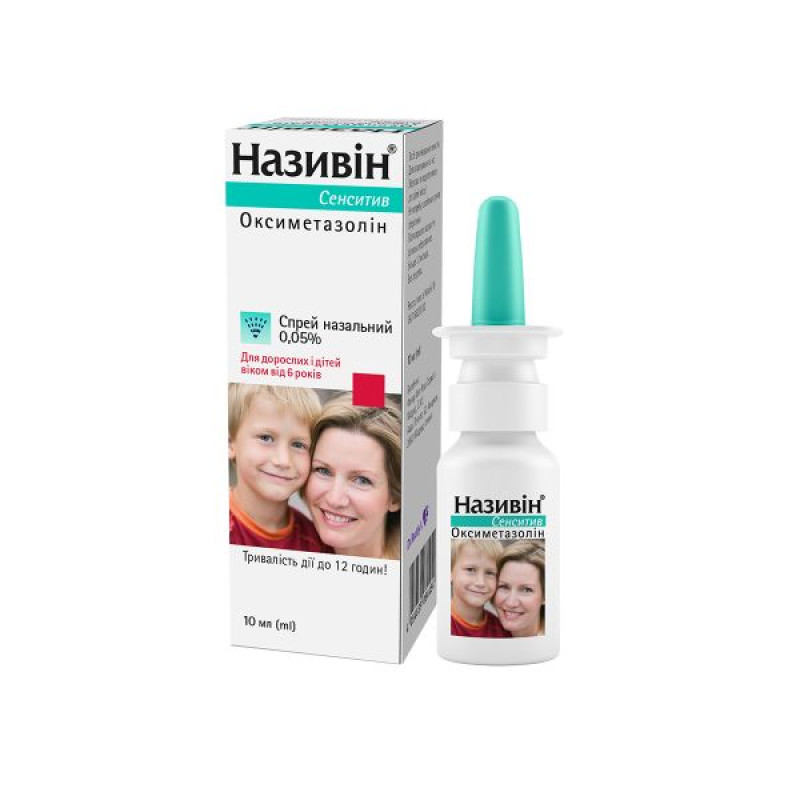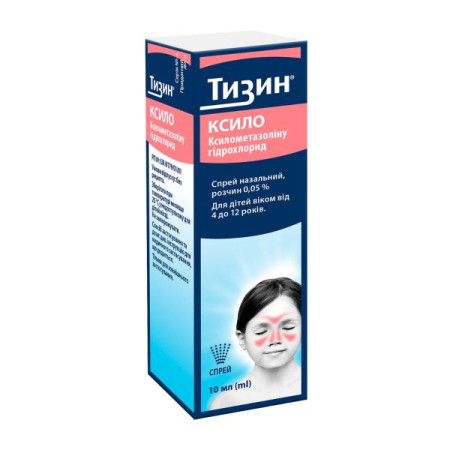Nazivin Sensitive nasal spray 0.05% bottle 10 ml

Instructions for use Nazivin Sensitive nasal spray 0.05% bottle 10 ml
Composition
active ingredient: oxymetazoline;
1 ml of 0.05% solution contains 0.5 mg of oxymetazoline hydrochloride;
Excipients: citric acid monohydrate; sodium citrate; glycerin (85%); purified water.
Dosage form
Nasal spray.
Main physicochemical properties: almost transparent, colorless to slightly yellowish solution.
Pharmacotherapeutic group
Anti-edematous and other drugs for topical use in diseases of the nasal cavity. Sympathomimetics.
ATX code R01A A05.
Pharmacological properties
Pharmacodynamics
Nazivin® Sensitive belongs to the group of local vasoconstrictors. Oxymetazoline has a sympathomimetic and vasoconstrictor effect, eliminating swelling of the nasal mucosa. Narrows the vessels at the site of application, reduces swelling of the nasal mucosa and upper respiratory tract, reduces nasal discharge. Restores nasal breathing. Elimination of swelling of the nasal mucosa contributes to the restoration of aeration of the paranasal sinuses and middle ear cavity, which prevents the development of bacterial complications.
Oxymetazoline has antiviral, anti-inflammatory, immunomodulatory and antioxidant effects. Thanks to this combined mechanism of action, clinical studies have proven a faster and more effective elimination of symptoms of acute rhinitis (nasal congestion, rhinorrhea, sneezing, malaise).
When applied topically to the nose in therapeutic concentrations, it does not irritate the nasal mucosa or cause hyperemia. The half-life is about 35 hours after application. 2.1% of the drug is excreted by the kidneys, about 1.1% with feces.
The duration of action of the drug is up to 12 hours.
Treatment with 0.05% oxymetazoline nasal spray significantly reduced the duration of the common cold compared with saline, from a mean of 6 days to 4 days (P < 0.001). A double-blind, parallel-group study in 247 adult patients demonstrated a faster and more effective reduction in typical symptoms of acute rhinitis [nasal congestion, runny nose, sneezing, malaise (P < 0.05)] due to the combination of vasoconstrictor, antiviral, anti-inflammatory, and antioxidant effects of oxymetazoline.
Indication
Acute rhinitis; allergic rhinitis; attacks of non-infectious vasomotor rhinitis; to restore drainage and nasal breathing in diseases of the paranasal sinuses of the nasal cavity, eustachitis associated with rhinitis; to eliminate edema before diagnostic manipulations in the nasal passages.
Contraindication
Hypersensitivity to oxymetazoline or any other component of the drug; atrophic rhinitis; do not use after transsphenoidal hypophysectomy or other surgical interventions with exposure of the meninges; when using monoamine oxidase inhibitors (MAO) and within 2 weeks after stopping treatment with MAO inhibitors, and when using other drugs that contribute to an increase in blood pressure; increased intraocular pressure, especially in angle-closure glaucoma; severe forms of cardiovascular diseases (e.g., ischemic heart disease) and arterial hypertension; pheochromocytoma; metabolic disorders (e.g., hyperthyroidism, diabetes mellitus); prostatic hyperplasia; porphyria.
Nazivin® Sensitive 0.025% is contraindicated for infants and children under 1 year of age, and Nazivin® Sensitive 0.05% is contraindicated for children under 6 years of age.
Interaction with other medicinal products and other types of interactions
Concomitant use of oxymetazoline with MAO inhibitors of the tranylcypromine type, tricyclic antidepressants, and antihypertensives may increase blood pressure. Therefore, these drugs should not be used together.
Application features
Long-term use and overdose of the drug should be avoided. Long-term use of a nasal decongestant may lead to a weakening of the drug's effect. Abuse of this drug may cause mucosal atrophy and reactive hyperemia with rhinitis medicamentosa.
Ability to influence reaction speed when driving vehicles or other mechanisms
When used in therapeutic doses, the drug does not affect the reaction rate when driving or using other mechanisms. However, a general effect on the cardiovascular and nervous systems cannot be excluded.
Use during pregnancy or breastfeeding
Data on the effects of the drug in a limited number of women in the first trimester of pregnancy do not indicate the development of adverse reactions that would affect the course of pregnancy or the health of the fetus/newborn. Other epidemiological data are currently unavailable. Animal studies have shown reproductive toxicity at doses exceeding therapeutic doses. The drug should be used with caution during pregnancy only after a careful assessment of the risk to the fetus and the benefit to the mother. During pregnancy, the recommended dosage should not be exceeded, as overdose may impair the blood supply to the fetus.
Breast-feeding
Data on the penetration of oxymetazoline into breast milk are unknown. The drug should be used during breastfeeding only if the benefit-risk ratio is carefully assessed. During breastfeeding, the recommended dosage should not be exceeded, as an overdose may reduce the amount of breast milk in the mother.
Method of administration and doses
Nazivin® Sensitive, nasal spray, intended for use in the nose.
Children aged 1 to 6 years - 1 injection of Nazivin® Sensitive 0.025% into each nasal passage 2-3 times a day. A single dose should not be used more than 3 times a day and for longer than 7 days. Doses higher than recommended should not be used.
Adults and children over 6 years of age – 1 spray of Nazivin® Sensitive 0.05% into each nasal passage 2-3 times a day. A single dose should not be used more than 3 times a day and for longer than 7 days. Doses higher than recommended should not be used.
The spray mechanism is activated by pressing the dosing device. Before using the spray for the first time, remove the protective cap and periodically press the dosing device to ensure a stable spray. Hold the bottle under the nasal passage and spray once. After that, clean the dosing device and put on the protective cap.
Children
Nazivin® Sensitive 0.05% should be used in children over 6 years of age.
Overdose
Overdose may occur after nasal or accidental oral administration. The clinical picture of intoxication with imidazole derivatives may be ambiguous, since periods of stimulation may alternate with periods of depression of the central nervous, cardiovascular and respiratory systems.
Central nervous system stimulation may manifest as anxiety, agitation, hallucinations, and spasms.
Central nervous system depression may manifest as decreased body temperature, lethargy, drowsiness, and possible coma.
The following symptoms may also occur: miosis, mydriasis, fever, sweating, pallor, cyanosis, rapid heartbeat, tachycardia, bradycardia, arrhythmia, cardiac arrest, hypertension, shock-like hypotension, nausea, vomiting, respiratory failure and apnea, and mental disorders.
In particular, in children, overdose may cause mainly central nervous system effects: spasms and development of coma, bradycardia, apnea, as well as arterial hypertension, with a possible transition to arterial hypotension.
Independent intensive care is indicated in cases of severe overdose. Immediate administration of activated charcoal (absorbent), sodium sulfate (laxative) or gastric lavage (in case of overdose with a large amount of the drug) is recommended, since oxymetazoline can be rapidly absorbed.
The use of vasopressor drugs is contraindicated. Non-selective α-blockers can be used as an antidote. If necessary, measures can be taken to reduce body temperature, carry out anticonvulsant therapy and ventilation of the lungs.
Adverse reactions
Adverse reactions are classified by frequency of occurrence into the following categories: very common (≥ 10%), common (≥ 1% and < 10%), uncommon (≥ 0.1% and < 1%), rare (≥ 0.01% and < 0.1%), very rare (< 0.01%) and rare cases.
From the nervous system.
Very rare: restlessness, insomnia, fatigue (drowsiness, sedation), headache, hallucinations (especially in children).
From the cardiovascular system.
Rare: palpitations, tachycardia, hypertension.
Very rare: arrhythmias.
On the part of the respiratory system.
Common: nasal discomfort (e.g. burning) or dryness of the nasal mucosa, sneezing.
Uncommon: after the effect of using Nazivin® Sensitive wears off, there is a feeling of severe nasal congestion, nosebleeds.
Very rare: Apnoea in infants and newborns.
On the part of the musculoskeletal system.
Very rare: convulsions (especially in children).
From the immune system.
Uncommon: hypersensitivity reactions (angioedema, rash, itching).
Expiration date
3 years.
After first opening – no more than 12 months.
Storage conditions
Does not require any special storage conditions. Keep out of the reach of children!
Packaging
10 ml of the drug in a bottle; 1 bottle in a cardboard box.
Vacation category
Without a prescription.
Producer
1. P&G Health Austria GmbH & Co. OG (Batch Release Authorization)
3. Famar Health Care Services Madrid, SAU (Full cycle production).
Location of the manufacturer and its business address
1. Hosslgasse 20, 9800 Spittal an der Drau, Austria / Hosslgasse 20, 9800 Spittal an der Drau, Austria.
2. Av. das Industrias - Alto do Colaride, Cacém, 2735-213, Portugal.
3. Avda. Leganes, 62, Alcorcon, 28923 Madrid, Spain/Avda. Leganes, 62, Alcorcon, 28923 Madrid, Spain.
There are no reviews for this product.
There are no reviews for this product, be the first to leave your review.
No questions about this product, be the first and ask your question.













